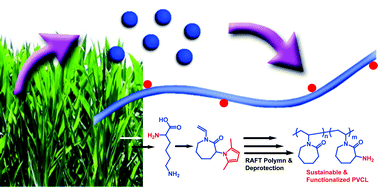Amino-functionalized poly(N-vinylcaprolactam) derived from lysine: a sustainable polymer with thermo and pH dual stimuli response†
Abstract
Lysine, a renewable feedstock with economic feasibility, was tactfully cyclized to its corresponding cyclic lysine and then subjected to a reaction with acetylenes to yield a sustainable N-vinylcaprolactam (VCL) derivative. Subsequent MADIX/RAFT copolymerization of the resultant monomer gave well-defined PVCL bearing pendant 2,5-dimethylpyrrole protected amino groups with narrow polydispersity. 1H NMR, SEC and MALDI-TOF-MS evaluations of the polymers demonstrated the controlled feature of the polymerization. Cleavage of the 2,5-dimethylpyrrole protecting group produced amino-functionalized PVCL showing pH regulated thermo responsiveness. The lower critical solution temperature (LCST) can be regulated from 34 to 64 °C, by varying pH values, salt concentrations, and the molar percentage of amino groups. Moreover, these amino-functionalized PVCL exhibited cell compatibility. Thus, we have demonstrated a sustainable approach to regulate pH- and thermal-sensitivity of PVCL, while retaining most structural and chemical identity of PVCL.



 Please wait while we load your content...
Please wait while we load your content...